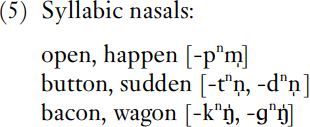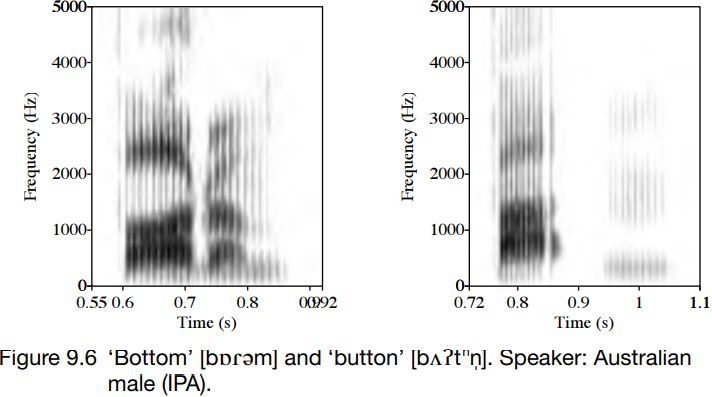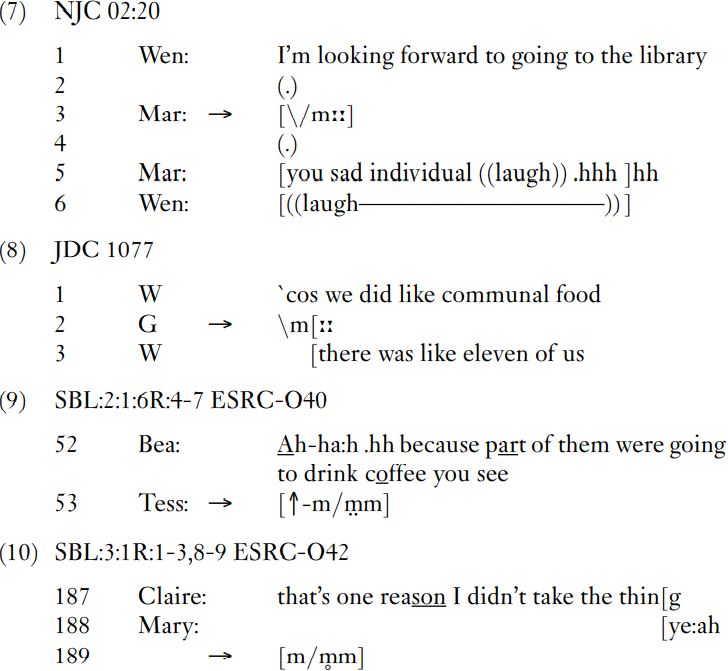


 Grammar
Grammar
 Tenses
Tenses
 Present
Present
 Past
Past
 Future
Future
 Parts Of Speech
Parts Of Speech
 Nouns
Nouns
 Verbs
Verbs
 Adverbs
Adverbs
 Adjectives
Adjectives
 Pronouns
Pronouns
 Pre Position
Pre Position
 Preposition by function
Preposition by function 
 Preposition by construction
Preposition by construction
 Conjunctions
Conjunctions
 Interjections
Interjections
 Grammar Rules
Grammar Rules
 Linguistics
Linguistics
 Semantics
Semantics
 Pragmatics
Pragmatics
 Reading Comprehension
Reading Comprehension|
Read More
Date: 2023-09-11
Date: 25-6-2022
Date: 2023-05-31
|
Nasals can be syllabic in English. This means that they occur in syllables without vowels in unstressed syllables. The patterns of distribution for syllabic nasals are not well understood, and there is some disagreement in the literature and among dictionaries over which words have syllabic nasals (which could be a matter of personal or social preference), and over what the definition of a syllabic nasal is.
The most straightforward cases of syllabic nasals are ones where there is a homorganic plosive + nasal sequence. Some examples of words like this are:

Syllabic nasals can be thought of as a product of the join between the plosive and the nasal portions of the words. We will start with the simplest case, ‘button’. This word has an alveolar plosive [t] with nasal release into an alveolar nasal [n].
Between the [t] and the [n], then, there is no intervening vocalic portion. This is because by definition vowels have unimpeded airflow through the vocal tract, but all through the sequence  , the tongue makes a complete closure against the alveolar ridge. For this reason, the nasal in a sequence like
, the tongue makes a complete closure against the alveolar ridge. For this reason, the nasal in a sequence like  in words like ‘button’ is considered to be syllabic. This is more precisely transcribed as
in words like ‘button’ is considered to be syllabic. This is more precisely transcribed as  .
.
Similar sequences can be made at other places of articulation: so words like ‘happen’ can be pronounced as  , and words like ‘bacon’ can be pronounced as
, and words like ‘bacon’ can be pronounced as  , with syllabic bilabial and velar nasal portions respectively.
, with syllabic bilabial and velar nasal portions respectively.
Figure 9.6 shows spectrograms for the words ‘bottom’ [bɑɾəm] and ‘button’  as spoken by an Australian male speaker.
as spoken by an Australian male speaker.

The spectrograms show very clear differences between the non-syllabic and syllabic nasals. The non-syllabic nasal is on the left: at about time 0.74 s, there is a short vocalic portion followed by a portion starting around 0.8 s which has the low amplitude associated with nasals. In the case of ‘button’, there is a glottal stop at around 0.85 s, followed by a silent portion, during which airflow through the vocal tract ceases and an alveolar closure is made; and then at about 0.95 s, voicing starts again. Notice the low amplitude of this portion of the spectrogram: this is consistent with a nasal release.
These cases are straightforwardly syllabic nasals, because the plosive and nasal portions are homorganic: they share the same place of articulation. Slightly more difficult is the case of e.g. fricative + nasal, as in ‘prison’, ‘reason’, ‘often’, ‘rhythm’, ‘oven’. In these cases, the two consonants do not necessarily share a place of articulation. For them to be syllabic, the join between the fricative portion and the nasal portion requires the oral closure for the nasal consonant to be made without a more open gesture intervening between the gesture of close approximation for the fricative and the oral closure needed for the nasal. This is easy to achieve in words like ‘prison’, where the tongue needs merely to be raised so as to make a complete closure against the alveolar ridge, giving  . But such words can easily be produced with a lowering of the tongue tip first, so that the transition between [z] and [n] does allow for a vocalic portion, [-zən]. This is likely also to be nasalized,
. But such words can easily be produced with a lowering of the tongue tip first, so that the transition between [z] and [n] does allow for a vocalic portion, [-zən]. This is likely also to be nasalized,  . Auditorily, there might not be much difference between the syllabic and non-syllabic versions, especially if the vocalic portion is short.
. Auditorily, there might not be much difference between the syllabic and non-syllabic versions, especially if the vocalic portion is short.
The word ‘and’ is regularly pronounced as a syllabic nasal (with varying places of articulation), even when it comes at the start of an utterance.
Syllabic nasals can also be found in nasal + plosive + nasal sequences, which are more common than one might expect. The distribution here is more difficult to explain: e.g. the name ‘Clinton’ (the former US president) is  .
.
Here is an example of a syllabic nasal by an American speaker, where the word ‘something’ has two different forms in the same turn. The second one has a nasal + plosive + nasal cluster:

Syllabic nasals are often used as response tokens in conversation. Both mono- and di-syllabic versions are found. Monosyllabic tokens are mostly bilabial in English. In the disyllabic tokens, there is usually a glottal stop or a portion of voicelessness or breathiness in the middle. The place of articulation is usually bilabial, but alveolar tokens are also found. These are one of the few places in English where voiceless nasals are found.
The transcriptions in (7) below are all taken from conversational data. For the sake of completeness, intonation is marked on the syllabic nasal portions: / means the intonation falls then rises; ↑– means the syllable has a relatively high, level pitch; / means the intonation rises. Neither the forms nor the functions of tokens like these are very well understood.

So far the syllabic nasals we have looked at have all been word final, but they can also occur word medially too, especially when there is a morpheme after the nasal. For example, the word ‘instances’, which has a plural morpheme  , can have a syllabic nasal:
, can have a syllabic nasal:  .
.
One good place to observe this is in verbs formed from adjectives with the suffix ‘-en’. For instance, the adjective ‘bright’ has a related verb ‘brighten’, which can be produced as  . This verb can be inflected, producing the form ‘brightening’ (as in: ‘the weather’s brightening up now’), which can be pronounced as
. This verb can be inflected, producing the form ‘brightening’ (as in: ‘the weather’s brightening up now’), which can be pronounced as  . The past tense form is correspondingly
. The past tense form is correspondingly  . Words like this can also be produced without the syllabic nasal, in which case the release of the alveolar closure is different: compare
. Words like this can also be produced without the syllabic nasal, in which case the release of the alveolar closure is different: compare  .
.
Syllabic consonants are not obligatory in these contexts, and in cases where the morphological form is less transparent, syllabic nasals are less likely. A well-known pair is ‘lightening’ (‘light’ + ‘-en’ + ‘ing’),  (with three syllables), and ‘lightning’,
(with three syllables), and ‘lightning’,  (with two syllables). Another example is ‘frightening’ – although this is derived from ‘fright’ + ‘-en’ + ‘-ing’, it behaves more like a monomorphemic word, and is more likely to be
(with two syllables). Another example is ‘frightening’ – although this is derived from ‘fright’ + ‘-en’ + ‘-ing’, it behaves more like a monomorphemic word, and is more likely to be  (parallel with ‘lightning’) than
(parallel with ‘lightning’) than  (parallel with ‘lightening’).
(parallel with ‘lightening’).
|
|
|
|
التوتر والسرطان.. علماء يحذرون من "صلة خطيرة"
|
|
|
|
|
|
|
مرآة السيارة: مدى دقة عكسها للصورة الصحيحة
|
|
|
|
|
|
|
نحو شراكة وطنية متكاملة.. الأمين العام للعتبة الحسينية يبحث مع وكيل وزارة الخارجية آفاق التعاون المؤسسي
|
|
|